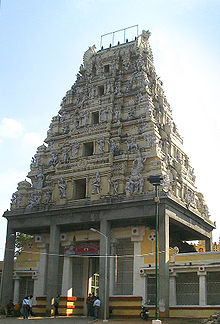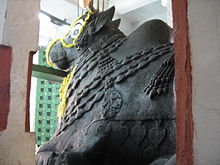| This article needs additional citations for verification. Please help improve this article by adding citations to reliable sources. Unsourced material may be challenged and removed. Find sources: "Dodda Basavana Gudi" – news · newspapers · books · scholar · JSTOR (December 2019) (Learn how and when to remove this message) |
| Dodda Basavana Gudi | |
|---|---|
| ದೊಡ್ಡ ಬಸವನ ಗುಡಿ | |
 View of the Bull temple View of the Bull temple | |
| Religion | |
| Affiliation | Hinduism |
| District | Bengaluru Urban |
| Deity | Basava |
| Location | |
| Location | Bengaluru |
| State | Karnataka |
| Country | India |
| Geographic coordinates | 12°56′34.42″N 77°34′5.55″E / 12.9428944°N 77.5682083°E / 12.9428944; 77.5682083 |
| Architecture | |
| Type | Vijayanagara |

Dodda Basavana Gudi (the Nandhi Temple) is situated in Bull Temple Road, Basavanagudi, area of South Bengaluru, part of the largest city of the Indian state of Karnataka. The Hindu temple is inside a park called Bugle Rock.
The bull referred to is a sacred Hindu demi-god, known as Nandi; Nandi is a close devotee and attendant of Shiva. Dodda Basavana Gudi is said to be one of the biggest temple to Nandi in the world. The stone monolith idol of Nandi is continually covered with new layers of butter, benne in the local language of Kannada. There is an idol of the elephant-headed Hindu deity Ganesha close by.
Every year on the last Monday and Tuesday of the Hindu month of Karthika Maasa a groundnut fair is held in the temple premises and groundnut is offered to the deity. This fair is known as 'Kadalekaayi Parishe' in local tongue. Groundnut sellers and devotees throng the place during Kadalekaayi Parishe.
Basavana Gudi is a regular place of visit for tourists and is covered by most of the tour operators including the Karnataka State Tourism Development Corporation.
The Bull Temple




Nandi Temple is exclusively for the worship of the sacred bull (Basava in Kannada) in Hinduism, known as Nandi, Lord Shiva's vahana. The word "nandi" means "joyful" in Sanskrit.
The temple was built in 1537 by Kempe Gowda under the Vijayanagara empire in the Vijayanagara architectural style, he also founded the city of Bengaluru. The temple is named after the large granite Nandi monolith placed on a plinth in the temple shrine (garbhagriha) which has become blackened from years of being rubbed with charcoal and oil. The temple is a small one, consisting only of the shrine fronted by a porch in the Vijayanagara style. The current tower (vimana) over the shrine was constructed in the early 20th century and is adorned with Saivite figures and motifs.
It is said to house one of the largest Nandi murthis in the world. The height of the murthi is approximately 15 ft (4.6 m) and it is approximately 20 feet (6.1 m) long.
Legend
A few hundred years ago, there was a small village called Basavanagudi in Bengaluru, Karnataka. Farmers in Basavanagudi and neighboring villages like Sunkenahalli, Gavipuram Guttahalli, Mavalli, and Dasarahalli cultivated groundnuts. These farmers faced a recurring problem: every full moon night, a bull would charge into the groundnut fields and cause significant damage, leading to heavy losses.
One night, the farmers decided to confront the bull. When it appeared, they chased it as it ran swiftly over a hillock. However, upon reaching the top, the bull vanished, and instead, they found an idol of Nandi (also called Basava in Kannada). To their astonishment, the idol began to grow in size. The farmers drove an iron peg into the head of the idol to stop it from growing further. Interpreting the bull's appearance and the discovery of the idol as a divine sign, they pledged to offer their first crop to Nandi.
They built a temple dedicated to Nandi Basava, which is now known as the Basavanagudi or Bull Temple. The Nandi idol stands 15 feet tall and 20 feet long. The day the farmers offer their first groundnut harvest is celebrated as Kadalekai Parishe. This two-day fair takes place near the Basavanagudi Bull Temple and attracts farmers from distant villages who come to offer their first crop to Nandi. Besides groundnuts, the fair features traditional dolls, toys, bangles, food items, and other goods, providing farmers with an opportunity to make a living from their produce.
Bugle Rock garden
The Bugle Rock garden is behind the Dodda Ganesha temple and adjacent to the Bull temple. The garden gets its name from a bugle call made on top of a very large rock formation to alert the nearby dwellers. It is densely covered with trees and one can usually see and hear a number of bats perched on the trees. There is a water tank with motifs of famous people from Karnataka.

See also
Images
Notes
- "Bangalore Tourist Attractions".
- "Nandi Temple". Retrieved 18 March 2007.
- "Nandi". Retrieved 18 March 2007.
- "Tower". Retrieved 18 March 2007.
- "Basavanagudi Nandi Temple". Retrieved 18 March 2007.
References
- A., Raman (1994). Bangalore - Mysore. Orient Blackswan. p. 9. ISBN 9780863114311.
- Sharma, Dr. Shiv (2008). India - A Travel Guide. Diamond Pocket Books (P) Ltd. p. 651. ISBN 9788128400674.
External links
| Hindu temples in Bengaluru | ||
|---|---|---|
|  | |


